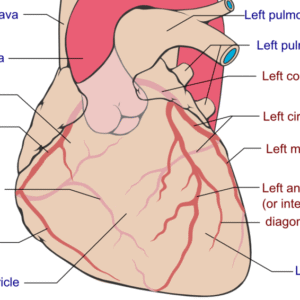Cardiology > Secondary Hypertension
Secondary Hypertension
Background
Secondary hypertension refers to elevated systemic arterial blood pressure resulting from an identifiable, often treatable, underlying cause. It accounts for approximately 5–10% of all hypertension cases. Unlike essential hypertension, secondary hypertension tends to present earlier in life, is often more severe or resistant to treatment, and may be curable if the underlying condition is addressed.
II) Classification/Types
By AHA/ACC BP Classification:
- Normal BP: <120/80 mm Hg
- Elevated BP: 120–129/<80 mm Hg
- Stage 1 HTN: 130–139/80–89 mm Hg
- Stage 2 HTN: ≥140/90 mm Hg
- Hypertensive Crisis: ≥180/120 mm Hg (urgency vs. emergency based on target-organ damage)
By Etiology (Secondary Causes):
- Renal parenchymal disease
- Renovascular hypertension
- Primary hyperaldosteronism
- Pheochromocytoma
- Cushing’s syndrome
- Coarctation of the aorta
- Obstructive sleep apnea (OSA)
- Drug-induced hypertension
III) Pathophysiology
The pathogenesis of secondary hypertension varies with the underlying cause:
- Renal causes: sodium and volume retention due to impaired excretion or renal ischemia
- Endocrine disorders: excess aldosterone, catecholamines, or cortisol increase vascular tone or volume
- OSA: intermittent hypoxia triggers sympathetic activation and RAAS
- Drug-induced: substances raise BP via vasoconstriction, fluid retention, or neurohormonal stimulation
Persistent hypertension in these cases can lead to vascular remodeling, left ventricular hypertrophy, and multi-organ damage.
IV) Epidemiology
- Accounts for ~5–10% of adult hypertension, higher in children and adolescents
- Common in patients with resistant hypertension or abrupt onset before age 30 or after age 55
- Frequently missed if not actively considered
- Treatable or potentially reversible if the underlying cause is identified early
Etiology
I) Causes (Grouped by System)
Renal
- Chronic kidney disease (CKD)
- Polycystic kidney disease
- Glomerulonephritis
- Renal artery stenosis (atherosclerotic or fibromuscular dysplasia)
- Endocrine
- Primary hyperaldosteronism (Conn syndrome)
- Cushing’s syndrome
- Pheochromocytoma
- Hyperthyroidism or hypothyroidism
- Acromegaly
Vascular
- Coarctation of the aorta
Sleep-related
- Obstructive sleep apnea
Medications/Substances
- NSAIDs, corticosteroids
- Oral contraceptives
- Decongestants (pseudoephedrine)
- Erythropoietin
- Cocaine, amphetamines
- Alcohol, licorice
II) Risk Factors
- Young age (<30) or older onset (>55) of hypertension
- Resistant hypertension (uncontrolled on ≥3 drugs)
- Sudden increase in BP or BP refractory to treatment
- Family history of endocrine tumors
- Paroxysmal symptoms (e.g., sweating, tachycardia)
- Hypokalemia, adrenal incidentalomas, or renal bruits
Clinical Presentation
I) History (Symptoms)
General: Often asymptomatic in early stages
Clues to Specific Causes:
- Episodic headaches, palpitations, diaphoresis → pheochromocytoma
- Muscle weakness, cramps, polyuria → hyperaldosteronism
- Weight gain, purple striae, moon facies → Cushing’s syndrome
- Fatigue, cold intolerance → hypothyroidism
- Snoring, daytime somnolence → OSA
- Flank pain, hematuria → renal parenchymal disease
II) Physical Exam (Signs)
- BP discrepancy in limbs (≥20 mm Hg): coarctation
- Abdominal or renal bruits: renovascular hypertension
- Facial plethora, central obesity: Cushing’s
- Signs of hyperthyroidism or hypothyroidism
- Retinopathy (hypertensive changes)
- Edema in CKD
- Signs of heart failure in advanced disease
Differential Diagnosis (DDx)
- Essential hypertension
- White coat hypertension
- Drug-induced BP elevation
- Anxiety or stress-induced elevation
- Pseudohypertension (elderly with stiff arteries)
- Transient BP elevations due to pain or illness
Diagnostic Tests
Initial Evaluation
- Accurate BP measurement (manual and HBPM or ABPM)
- Rule out white coat hypertension
- Evaluate for end-organ damage
Screening Labs
- BMP: assess kidney function, electrolytes (look for hypokalemia)
- Urinalysis: proteinuria, hematuria
- Fasting glucose or HbA1c
- Lipid panel
- TSH
Targeted Testing (Based on Suspicion)
- Plasma aldosterone/renin ratio: screening for hyperaldosteronism
- 24-hour urinary metanephrines or plasma-free metanephrines: pheochromocytoma
- Overnight dexamethasone suppression test: Cushing’s syndrome
- Renal ultrasound or CT angiography: renovascular disease
- Sleep study (polysomnography): obstructive sleep apnea
- Echocardiography: coarctation or cardiac effects
- Thyroid function tests
Treatment
I) Initial Approach
- Confirm diagnosis of hypertension
- Identify and treat the underlying cause
- Initiate antihypertensive therapy as needed
- Address modifiable lifestyle factors
- Coordinate with specialists when necessary
II) Non-Pharmacologic Measures
- Sodium restriction
- DASH diet
- Weight loss
- Exercise
- Limit alcohol
- Smoking cessation
- CPAP for OSA
III) Pharmacologic Therapy
Tailored to the cause:
- Renovascular: ACEi/ARB (caution in bilateral stenosis)
- Primary aldosteronism: Spironolactone or surgery
- Pheochromocytoma: α-blocker (e.g., phenoxybenzamine) → β-blocker → surgery
- Cushing’s: surgical or medical treatment
- CKD: ACEi/ARB to reduce proteinuria
- General BP control: Use standard agents if underlying cause is not correctable
Patient Education, Screening, Vaccines
Education
- Importance of identifying the underlying cause
- Medication adherence and lifestyle changes
- Signs of hypertensive emergencies
- Monitoring BP at home
Screening
- Screen high-risk individuals and young-onset cases
- Evaluate family history of endocrine tumors or renal disease
Vaccinations
- Influenza, COVID-19, pneumococcal vaccines
- Ensure up-to-date adult immunizations, especially in CKD patients
Consults/Referrals
- Nephrology: renal parenchymal disease or renovascular hypertension
- Endocrinology: adrenal or pituitary disorders
- Cardiology: resistant hypertension, coarctation
- Sleep medicine: OSA
- Hypertension specialist: persistent or refractory cases
- Surgery: adrenalectomy, renal revascularization, coarctation repair
Follow-Up
Short-Term
- Recheck BP in 1–4 weeks after initiating or adjusting treatment
- Monitor for improvement after addressing the secondary cause
Long-Term
- Regular follow-up every 3–6 months once BP is stable
- Repeat labs for kidney function, electrolytes, and underlying disorder
- Assess for recurrence or progression of hypertension
Prognosis
- Favorable if cause is identified and treated early
- Poor if untreated or misdiagnosed, with higher risk of complications such as stroke, MI, or CKD
Stay on top of medicine. Get connected. Crush the boards.
HMD is a beacon of medical education, committed to forging a global network of physicians, medical students, and allied healthcare professionals.

